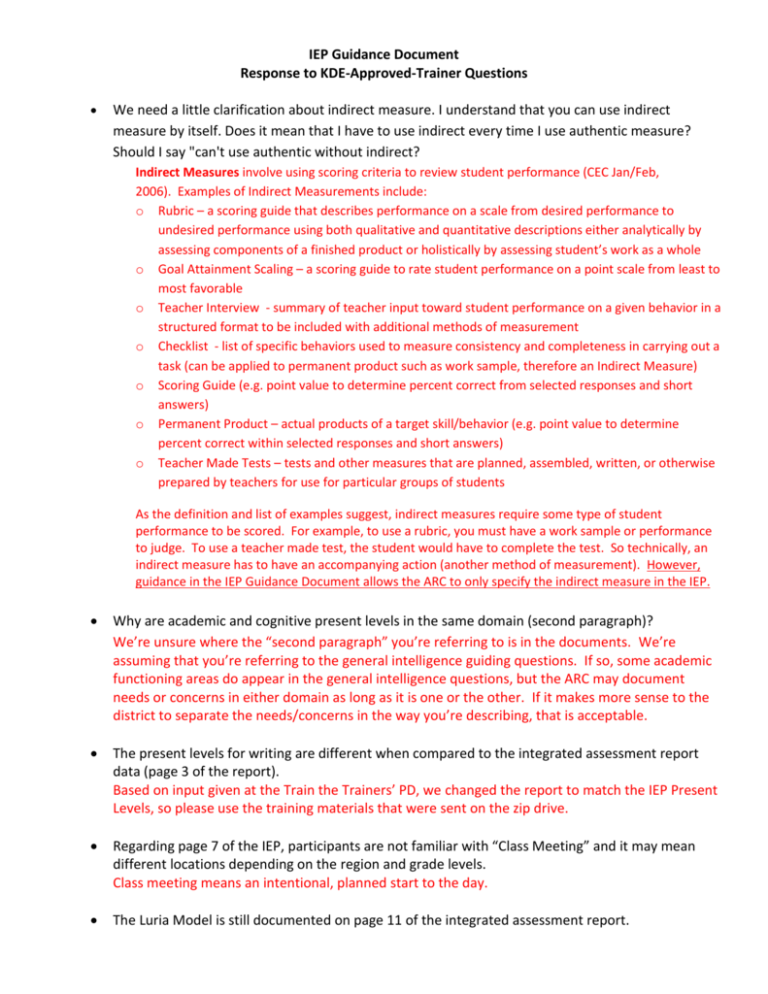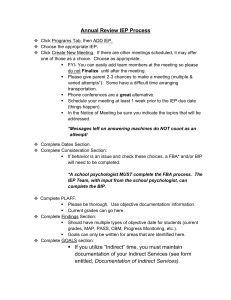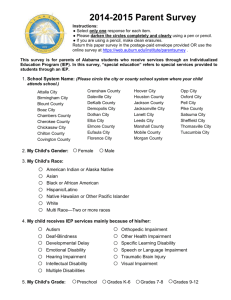IEP Questions State Approved Answers 2012
advertisement

IEP Guidance Document Response to KDE-Approved-Trainer Questions We need a little clarification about indirect measure. I understand that you can use indirect measure by itself. Does it mean that I have to use indirect every time I use authentic measure? Should I say "can't use authentic without indirect? Indirect Measures involve using scoring criteria to review student performance (CEC Jan/Feb, 2006). Examples of Indirect Measurements include: o Rubric – a scoring guide that describes performance on a scale from desired performance to undesired performance using both qualitative and quantitative descriptions either analytically by assessing components of a finished product or holistically by assessing student’s work as a whole o Goal Attainment Scaling – a scoring guide to rate student performance on a point scale from least to most favorable o Teacher Interview - summary of teacher input toward student performance on a given behavior in a structured format to be included with additional methods of measurement o Checklist - list of specific behaviors used to measure consistency and completeness in carrying out a task (can be applied to permanent product such as work sample, therefore an Indirect Measure) o Scoring Guide (e.g. point value to determine percent correct from selected responses and short answers) o Permanent Product – actual products of a target skill/behavior (e.g. point value to determine percent correct within selected responses and short answers) o Teacher Made Tests – tests and other measures that are planned, assembled, written, or otherwise prepared by teachers for use for particular groups of students As the definition and list of examples suggest, indirect measures require some type of student performance to be scored. For example, to use a rubric, you must have a work sample or performance to judge. To use a teacher made test, the student would have to complete the test. So technically, an indirect measure has to have an accompanying action (another method of measurement). However, guidance in the IEP Guidance Document allows the ARC to only specify the indirect measure in the IEP. Why are academic and cognitive present levels in the same domain (second paragraph)? We’re unsure where the “second paragraph” you’re referring to is in the documents. We’re assuming that you’re referring to the general intelligence guiding questions. If so, some academic functioning areas do appear in the general intelligence questions, but the ARC may document needs or concerns in either domain as long as it is one or the other. If it makes more sense to the district to separate the needs/concerns in the way you’re describing, that is acceptable. The present levels for writing are different when compared to the integrated assessment report data (page 3 of the report). Based on input given at the Train the Trainers’ PD, we changed the report to match the IEP Present Levels, so please use the training materials that were sent on the zip drive. Regarding page 7 of the IEP, participants are not familiar with “Class Meeting” and it may mean different locations depending on the region and grade levels. Class meeting means an intentional, planned start to the day. The Luria Model is still documented on page 11 of the integrated assessment report. Based on input given at the Train the Trainers’ PD, we checked with a PhD Psychologist. He pulled up the training from Kaufman and Kaufman and it states, “select the Luria Model with known or suspected language disorders.” We added this language to page 4, paragraph 3 of the report. Some felt it would be hard to monitor Sam’s progress under Degree/Criterion - “with at least 3 words” and at “80% accuracy across 3 out of 5 sessions.” As trainers, we will have to remind individuals that this is a state training with examples. We’ve included all the components (ABCDE) in the example. If they determine they would write it another way based on that child’s evaluation and Present Levels, as long as they have all the components, it would be okay. On page 78 of the PowerPoint, the second bullet from the bottom the location is defined as: “Include the content class (i.e., language arts, science, PE).” So is PE a content class across all grade levels? What about science? Content classes would be dependent on the individual child, grade and school. Slide 78 is aligned with pages 51-52 of the IEP Guidance Document. To further explain, the ARC first identifies the setting for the specially designed instruction, the ARC then identifies the class in which the student will receive the specially designed instruction. Also on page 52, there are more examples of how to document “location.” An additional example might be “regular class, PE, for social skills instruction.” Beginning with page 91 of the PowerPoint and pages after that, Progress Reporting and monitoring are interchanged. This appears confusing during trainings. Slide 91 will be corrected to read “Progress Monitoring Data Collection Cycle” and refer to page 62 in the Guidance Document. The steps on page 90 of the PowerPoint are not in the same order as the steps in the IEP Guidance Document on page 62. The purposes aren’t sequential, so it’s okay for the order to be different. We noticed that one bullet in the slide was left out of the document. You may ask participants to add “Provide data on student performance” to the list in their Guidance Document. The PowerPoint notes and the IEP Guidance Document indicate that all goals should be written using ABCDE. Both documents also state that methods of measurement may be listed below the goal. Will the updated Record Review document clarify this issue? The Record Review document has been revised to reflect this language. Do you have an example of “one statement that incorporates all Present Level areas impacted by the disability” as stated on page 11 of the guidance document? Not at this time; we will consider including an example in future IEP samples. IEP Questions July 2012 1. Could examples include benchmarks as objectives for easier comparison? The selection of using a benchmarks or objectives is a district decision. Second, the decision is determined by the annual goal. IEP Guidance Document, page 39, provides definitions of benchmarks and short term objectives and the construction for each. 2. Can models of priority goals based on grade levels standards be provided in the examples (i.e., 8th grade student on 1st grade level)? Annual goals are directly related to the student’s disability and pertain to needs described in the present levels. Goals are focused on bridging the gap from where the student is (baseline) to where the student needs to be (goal) and address both academic and functional skills (p. 31). Measureable annual goals and prioritization of annual goals are based on the individual needs of the student. The ARC should prioritize the skill area(s) that will have the most powerful impact on accelerating student performance from their current instructional level toward the identified age and grade level standards. A second case study will be released by November. The case study provides examples of an 8th grade student who has a Mild Mental Disability. He is working well below grade level. The student’s annual goals are aligned with the KCAS. 3. Should Assistive Technology (in Special Factors) always be checked for low and high tech devices... even if the device is only used periodically? If the assistive technology is necessary to implement the student’s IEP, then YES, check the Assistive Technology box in the Special Factors section. 4. If a student is LD eligible and has behavior issues, is it permissible to include a behavior goal on his/her IEP, or do the student’s behaviors need to be addressed in a different way? Annual goals are directly related to the student’s disability and pertain to the needs described in the present levels. A need or concern are areas in which there is an adverse effect, meaning the student performs significantly and consistently below the performance of similar grade and age peers as a result of the disability. All annual goals must be supported by assessment data which is directly reflected in the Present Levels. OR A student may have a relative behavioral weakness which may be addressed as you would with non-disabled peers such as behavior contract, social skill instruction provided by the counselor, Behavior Intervention Plans, school incentive systems. 5. If a student is LD eligible and has behavior issues, may that student have a Behavior Intervention Plan and an FBA? Yes, a student with a Specific Learning Disability may have a Behavior Intervention Plan to address behavioral issues. A Functional Behavior Assessment is required for Manifestation Determination, however an Admission and Release Committee may determine to do a FBA on a student at any time. 6. Can measurement be in the Objective rather than in the Annual Goal? The components of an annual goal include audience, behavior, circumstance, degree/criterion, and evaluation/method of measurement (page 31). The evaluation/method of measurement can be in the goal statement or following the prompt (page 34). 7. Will districts be held to the standards of the current IEP Guidance Document for preschool children since the preschool IEP is not yet available? The IEP Guidance Document outlines a process for IEP construction. The process is relevant to all students including preschool children. 8. On page 74 of the Power Point the last section states the following: Use of school staff- Additional adult supervision (note when and where) The group we were training felt this was stated in a way that made it appear to be addressing the needs of the student rather than a support service provided to the staff who would be providing the supervision. Program Modifications and Supports for School Personnel is a section to identify specialized training school staff may need, use of school time, and use of school staff (page 48). 9. How is the teacher of the visually impaired listed on the IEP? When he/she is providing Braille, reading, writing, etc. shouldn’t he/she be listed under Special Education Services rather than Related Services? Visual Impairment is a disability category. VI is not a related service. Therefore, the teacher of the visually impaired is a service provider for special education services (Expanded Core Content in Braille, Sensory Efficiency, SelfDetermination). 10. Scenario – Student is OHI or EBD and served 100% of the time in regular education with co-teaching in certain classes. The student has the occasional meltdown during which he/she must be removed from the regular education classroom to receive specially designed instruction in social skills in a resource setting. How are the minutes for this accounted for since there is no consistency in how frequently this will occur or in which classes? If this student has inconsistent behavior, the teacher needs to design and implement a proactive plan to support the student (e.g., classroom behavior management system, schedule of positive reinforcement when student behaves appropriately, and consistent, known consequences for inappropriate behaviors). Social skills instruction may be taught in a variety of settings including the regular classroom. The ARC may consider conducting a Functional Behavior Assessment to determine the function of the behavior to determine why student has occasional outbursts. 11. There continue to be very specific questions related to OHI and academic goals. We addressed this, but individuals still want a more clear cut answer. Is there any more specific guidance on this than what appears in the Guidance Document? The Especially DECS article pertaining to OHI and academic goals is located in Appendix D.




